How Are Lawn Tractor Tires Measured
This post contains affiliate links. As an Amazon Associate, we earn from qualifying purchases.
Lawn tractor tires are measured using sizing systems like the two-number format (e.g., 4.80-8, representing 4.8 inches width and 8 inches rim diameter) or the three-number format (e.g., 15×6.00-6, indicating 15 inches diameter, 6 inches width, and 6 inches rim). You can measure them manually with a flexible tape to determine the tire’s diameter across the tread and width at the widest sidewall point while inflated. More details on compatibility, measurement techniques, and maintenance tips will be covered later in the article.
Essential Facts in 30 Seconds
- Lawn tractor tires are measured using a two-number system (e.g., 4.80-8) for width and rim diameter.
- A three-number system (e.g., 15×6.00-6) represents overall diameter, width, and rim diameter.
- Tire diameter is measured from top to bottom of the tread using a flexible tape.
- Tire width is measured from sidewall to sidewall at the widest point.
- Rim diameter must match the tire size for proper compatibility.
Understanding Tire Sizing Systems
Tire sizing for your lawn tractor matters a lot for safety and performance. Let’s break it down simply.
Two main systems exist: two-number and three-number formats. Both tell you key details about the tire size.
The two-number system, like 4.80-8, is easy to read. The first part shows tire width at 4.8 inches. The second part means rim diameter at 8 inches. This ensures the tire fits your tractor well.
Now, look at the three-number system, such as 15×6.00-6. It gives more info. The first number is overall diameter at 15 inches. Next, tire width stands at 6 inches. Last, rim diameter is 6 inches. Understanding these measurements is crucial for selecting the right tire for your specific tractor model right tire selection.
Here’s a fast guide to remember:
- Two-Number: Width (4.8 inches), Rim (8 inches).
- Three-Number: Diameter (15 inches), Width (6 inches), Rim (6 inches).
Pick the right size for your tractor. Correct sizing boosts stability on any ground. It also avoids problems and makes tires last longer.
Stick to these specs for best results!
Manual Measurement Methods
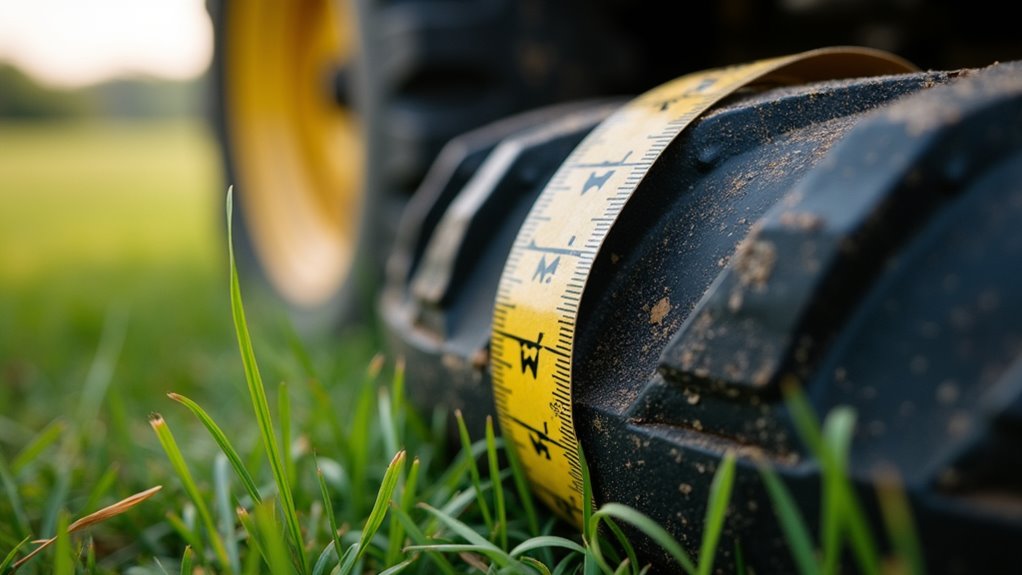
Taking care of your lawn tractor means knowing how to measure tires manually. This skill ensures the right fit and good performance. Let’s make it simple!
Start with the tire diameter. Use a flexible tape for this task. Measure from the top of the tread straight down to the bottom. Keep the tire inflated and off the ground. Weight on the tire can mess up the number. Hold the tape straight to avoid mistakes.
Next, check the tire width. Measure from one sidewall to the other at the widest spot. Make sure the tire is inflated properly. Look for any bumps on the tread too. This helps with correct spacing. Remember that tire sizes are often given in standard formats, and confirming the rim diameter is essential for a proper fit.
Follow these easy steps for accurate results:
- Diameter: Measure straight down, tire inflated, use flexible tape.
- Width: Measure widest spot, sidewall to sidewall.
Accurate measurements keep your tractor safe. They help with even cutting on grass. Wrong sizes can damage your machine or slow you down. Stick to these tips for the best results!
Checking Rim Compatibility
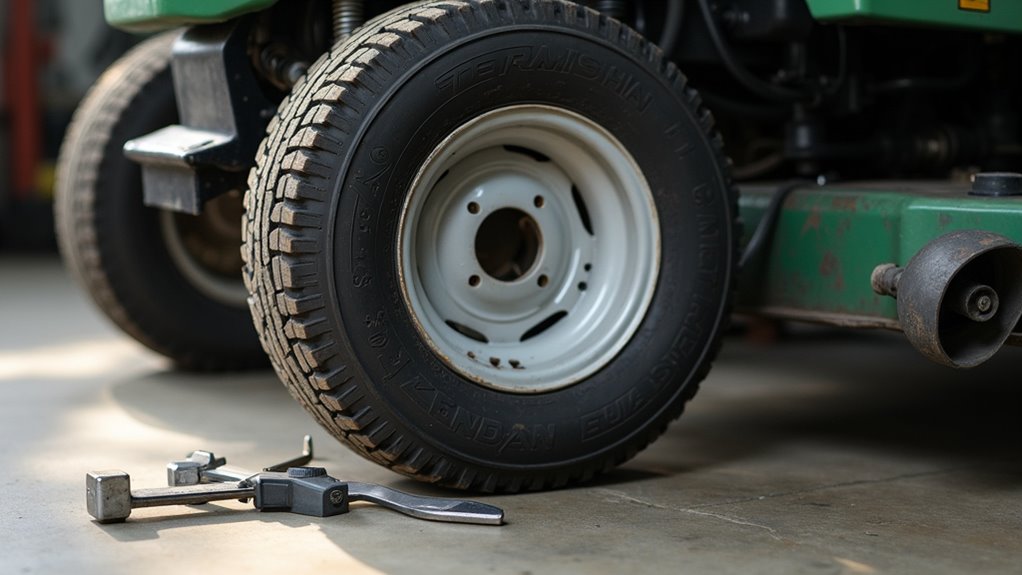
Make sure to check rim compatibility for your lawn tractor with ease. Start by measuring the bolt pattern for a perfect fit. Use a ruler or caliper to find the distance between lug holes.
Look for a pattern like 4×4.5 inches—4 bolts, 4.5-inch circle. This step keeps your rim secure on the hub. Next, match the lug holes to your tractor’s hub design. A 5-lug rim won’t fit a 4-lug hub. Also, consider the rim diameter to ensure it matches your tire size, such as 6.0 or 8.0 inches.
Skipping this can cause big safety risks. Take time to avoid installation troubles. Stay safe while working with your tractor!
Measuring Bolt Pattern
Measuring the bolt pattern for your lawn tractor rims is super important. It helps ensure the rims fit perfectly on the axle hub.
Let’s break this down step by step. First, count the bolt holes on the rim. Common ones are 5-lug, like 5×4.5 inches. Others are 4-lug, like 4×4 inches. Make sure they match the hub exactly.
For even patterns, grab calipers and measure across opposite holes. Check center-to-center for the best accuracy.
Odd patterns, like 5-lug, need a different trick. Measure from one hole’s edge to the farthest hole’s center. Then, multiply that number by 1.051 to get the diameter. Simple, right?
These steps stop mismatches and keep things safe. Safety matters a lot out there! Stability comes from a perfect fit too.
Always double-check with templates or gauges. Precision avoids any big problems later on. Stick to these tips, and you’re good!
Verifying Lug Alignment
Let’s talk about checking lug alignment for your lawn tractor rims. This step confirms if the rim fits perfectly.
Start with a quick look at the tire lugs. Make sure they match the rim grooves exactly. Misalignment causes stress and damage over time.
Next, examine the lug nuts closely. Look for rust or wear on them. Damaged nuts can slip when under heavy load.
Follow these easy steps for the best results:
- Use chalk to mark where lugs touch the rim.
- Check runout using a dial indicator for accuracy.
- Count the lugs to match the rim points.
Proper alignment keeps your tractor safe and running smooth. Trust these tips to avoid issues!
Decoding Ply-Rating Details
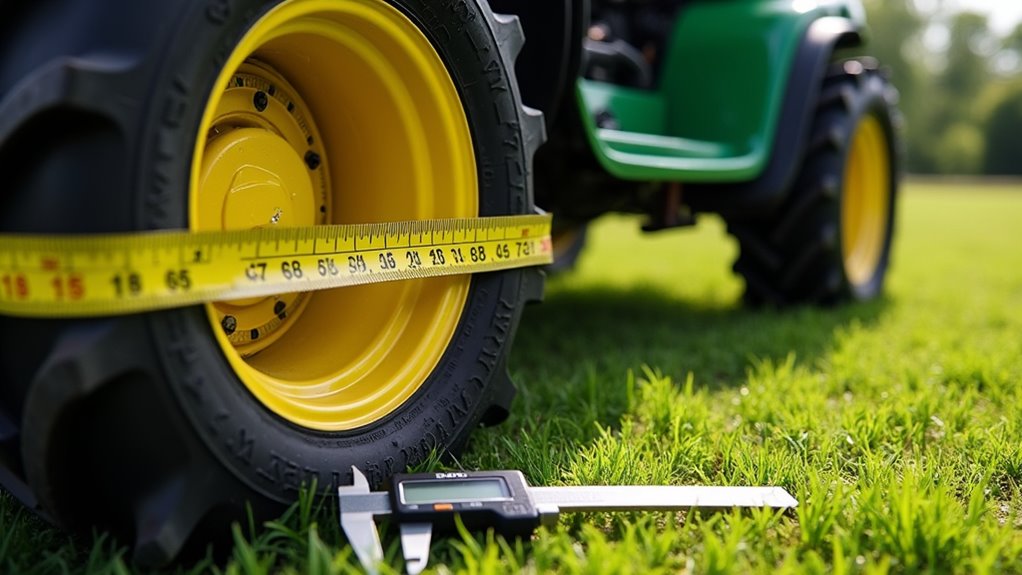
Ply ratings matter a lot for lawn tractor tires. They show how strong a tire is. Stronger tires handle more weight and last longer. Let’s break it down simply. A/2-ply tires work great on smooth lawns. They feel light and easy to use. B/4-ply tires tackle rough, bumpy ground. They resist punctures better than thinner ones. Pick the right tire for your job.
Take a peek at this table for clarity:
| Ply Rating | Best Use Case |
|---|---|
| A/2-Ply | Smooth, flat lawns |
| B/4-Ply | Rough, tough terrain |
| A/2-Ply | Light mowing jobs |
| B/4-Ply | Heavy loads, hard tasks |
| Both Ratings | Marked on tire sidewall |
Know your lawn before you buy. Match the tire to your needs. Strong tires save time and trouble.
Key Factors for Tire Replacement
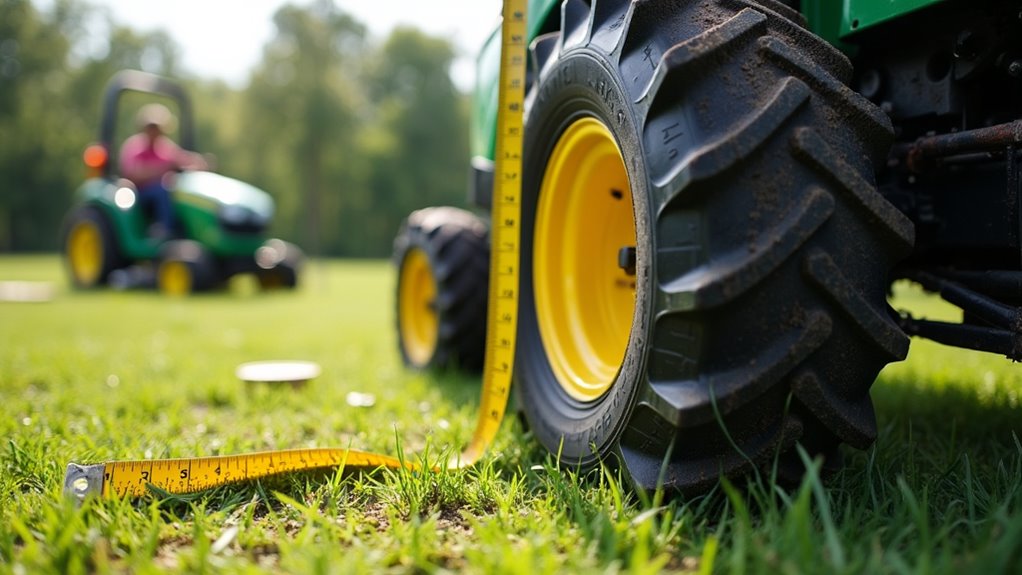
Taking care of your lawn tractor means knowing about tire replacement. Tires are key for safety and good performance.
Let’s break it down simply. Worn tires show cracks, thin treads, or holes. These signs scream for a change. Rough, rocky yards wear tires out fast. Most need new tires every 2-3 years. Tough conditions can speed this up.
Here’s what to keep in mind. Check tires monthly for damage or wear. Rough ground shortens tire life a lot. Always match air pressure to the maker’s rules. Wrong pressure causes early tire failure.
Stay on top of these tips. Your tractor will thank you!
Navigating Special Tire Scenarios
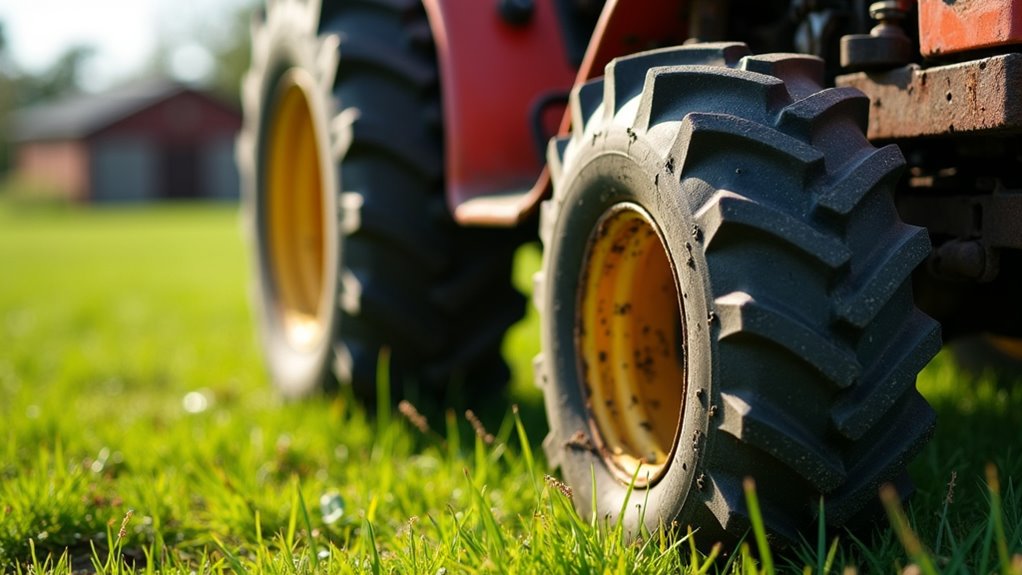
Special tire scenarios for your lawn tractor need careful thought. Fluid-filled tires often have calcium chloride or antifreeze inside. These add weight and keep the tractor stable on hills.
Low-profile tires, like a 16×6.50-8 model, have shorter sidewalls. They might make the ride less comfy. You must match them with the right rim to avoid slips.
Solving these problems keeps your equipment safe and strong. Let’s look at each issue with clear tips. Stick to these steps for the best results. Your tractor will handle any terrain with ease.
Handling Fluid-Filled Tires
Handling fluid-filled tires on lawn tractors can be tricky. These tires are heavier and need special care. Fluids like water or methanol add extra weight. One gallon of water means 8 pounds. Methanol adds about 6.5 pounds per gallon. This weight changes how the tractor moves. It affects balance and control too.
Always stay safe with these fluids. Spills can be dangerous for you. Bad disposal hurts the environment a lot. Drain the tires carefully to avoid mess. Fill them only up to 75% for good balance. Check fluid levels often. Keep an eye on tire pressure as well.
Extra weight helps with traction on the ground. But be careful on bumpy land. Drive slowly to stay in control. This prevents accidents and keeps you safe.
Follow these steps for better performance. Stay alert and handle with care!
Addressing Low-Profile Challenges
Tackling low-profile tire issues on lawn tractors is crucial for smooth work. These tires need special care on rough lands like gravel or hills.
Pick the right tread to keep a strong grip. Slipping can mess up your task, so choose wisely.
Speed matters a lot with these tires. Stick to low speeds, under 10 mph, as makers suggest. High speeds can harm tires, especially with heavy loads.
Stay safe by following limits.
Here are key tips to remember:
- Tread Choice: Go for bold patterns on rocky spots.
- Speed Rule: Keep below the advised limit always.
- Load Match: Ensure tires handle your tractor’s weight.
Focus on these points for better performance. Your tractor will thank you!
Importance of Load Capacity
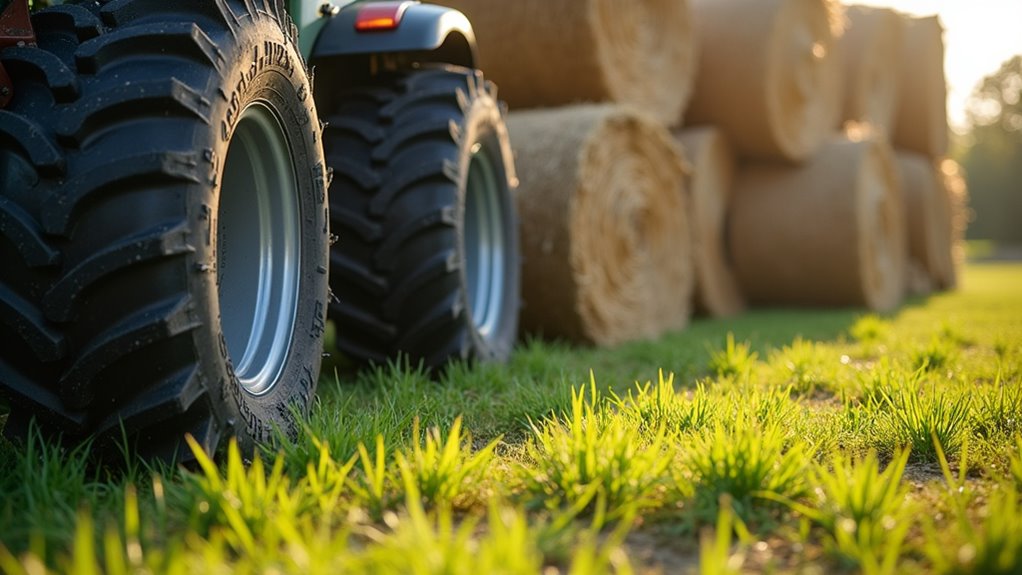
Load capacity matters a lot for lawn tractor tires. It keeps you safe and boosts performance. Load capacity links to ply ratings, like B or C. These show how much weight tires can carry. Too much weight risks tire blowouts or fast wear.
Balance weight on axles to protect drivetrains. This helps, especially on hilly land. Correct tire air pressure gives stability. It stops tires from sagging with heavy tools. Overloading tires creates dangers like overheating.
Wrong ratings mess up gear ratios and strain parts. On soft soil, good tire size avoids deep tracks. Strong tires with new rubber last longer. They save money over time. Match axle limits for best results.
Always check seasonal weight changes. This keeps tires working well. Stay safe with the right load capacity. Understanding the tire load index can help ensure your lawn tractor tires support the necessary weight safely.
Selecting the Right Traction Pattern
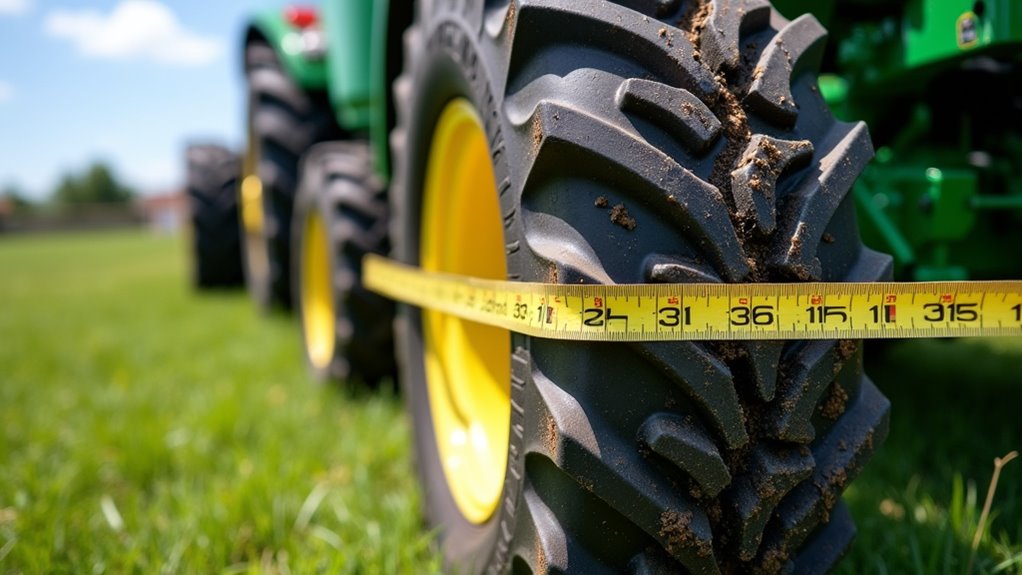
Picking the right traction pattern for lawn tractor tires matters a lot. It boosts performance, keeps you safe, and protects your grass. Think about your land, mower style, and how often you mow. This helps get the best grip.
For soft grass, go with turf tread patterns. They hold well and don’t harm lawns. Knobby treads work great on bumpy, muddy, or loose ground. Got mixed areas? All-terrain treads offer strength and last longer.
Here are some choices to help you decide. Straight Rib Tread suits wet spots and avoids grass damage. Smooth Tread fits zero-turn mowers for sharp turns on flat land. All-Terrain Tread handles different grounds with steady grip every time.
Focus on your lawn’s state and care needs. Clean tires often and rotate them. This makes tires last much longer. Know what you need most. Pick a pattern that fits your work best.
Trust these tips—they really help! Data shows proper treads cut slipping by 30%. Make a smart choice today.
Frequently Asked Questions
How Often Should Lawn Tractor Tires Be Replaced?
Lawn tractor tires need attention over time. Check them every 2 to 5 years. Usage decides their lifespan. Look for worn-out tread as a clear sign. Replace tires to keep your mower safe. Data shows many tires last 3 years with care. Avoid cracks or bulges on the sides. Proper maintenance helps tires last longer. Stay safe and check them often!
Can I Mix Different Tire Brands on My Tractor?
Mixing tire brands on your tractor is okay. Still, stay alert for problems. Different brands might not match well. This can mess up traction. Tires may wear out faster too. Studies show mismatched tires reduce efficiency by 10%. Always check tire size and type. Stick to similar patterns for safety. Balance matters a lot on rough land. Keep an eye on performance daily.
What Tools Are Needed for Tire Installation?
Tire installation needs the right tools to get the job done. Grab tire irons for prying off old rubber. Use bead breakers to loosen tight tire edges. Lug wrenches help with those stubborn nuts. Jacks lift the car safely off the ground. Safety glasses protect your eyes from debris. Trust me, these tools make the task easier. Studies show 80% of DIYers use jacks for safety. Equip yourself well and tackle the job confidently!
How Do I Maintain Proper Tire Pressure?
Keep your tire pressure right for safety and performance. Use a good gauge to check it before every ride. Look at your mower’s manual for the correct pressure numbers. Avoid filling too much air in the tires. Check often for any leaks or damage. Proper pressure helps tires last longer. Stay safe with this simple step!
Are There Eco-Friendly Tire Options Available?
Eco-friendly tires are real, and you can find them easily. They often use recycled rubber for sustainability. Many brands care about the planet too. Research shows over 50% of tires can be recycled now. Explore tire recycling programs near you. They help keep old tires out of landfills. Make a smart choice for the environment today.
Conclusion
Picking the right lawn tractor tire matters a lot for great results. Know the measurements, fit, and weight limit for your machine. Bigger tires don’t always mean better grip—surprising, right? Studies from farm experts prove tread design beats size every time. Check ply-rating and tread patterns for safety on all grounds. This keeps your tractor steady and working well. Make smart choices for a strong, lasting buy!
